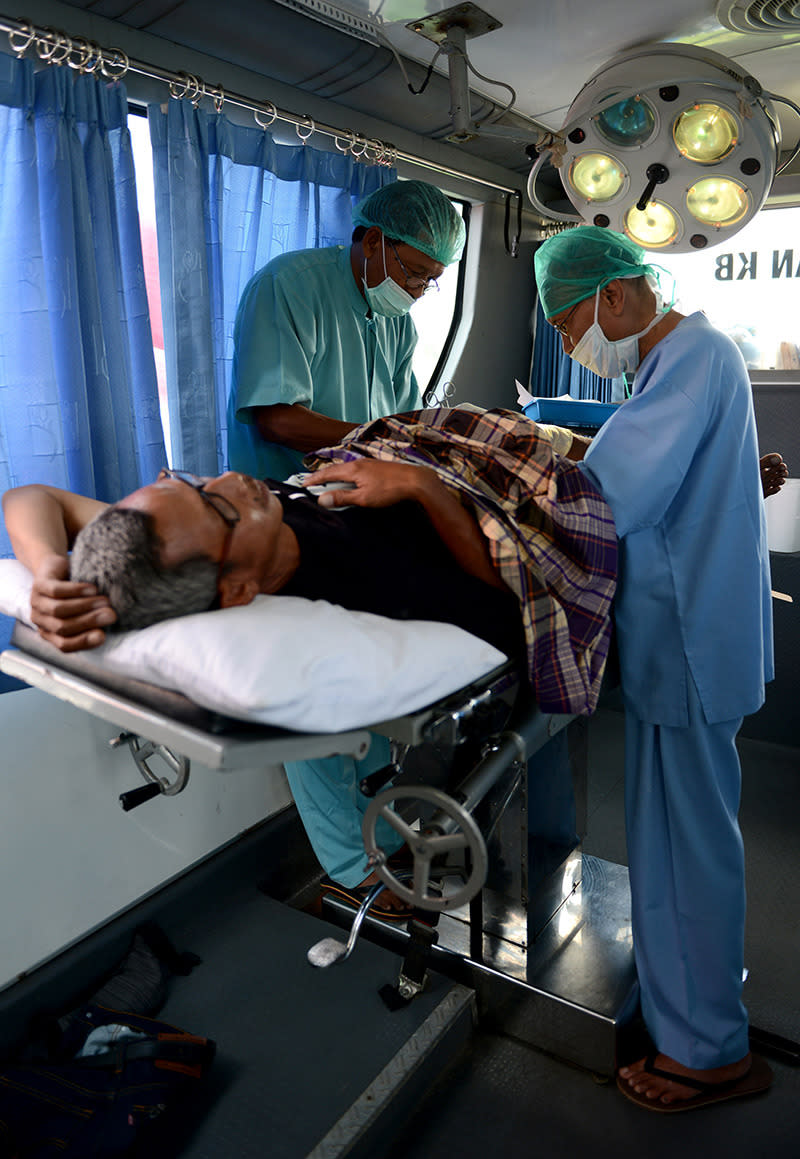The Reasons Behind Low Vasectomy Rates Around the World – Including the U.S.

Doctors give an unidentified man a vasectomy in an Indonesian clinic. (Photo: Getty Images)
Inside a small, open-air clinic in Yogyakarta, Indonesia, 42-year-old Suwardi sits cross-legged on a wooden bench, staring quietly ahead, waiting to be called into the operating room. I am cross-legged beside him, watching cars and mopeds whiz by on a street that shimmers from the heat only a few dozen feet from where we sit. Suwardi seems unfazed as he waits to undergo a vasectomy. I am in Indonesia as a U.N. Foundation press fellow and, though I’ve been invited to observe the procedure by local physician Dr. Tri Gunawan, I assume Suwardi would prefer my absence in the operating room. My interpreter turns to Suwardi and asks he’d mind if I observe the procedure.
He waves his hand casually and speaks quickly in Bahasa. “He doesn’t mind. You can go in,” the interpreter tells me. According to Indonesia’s National Coordinating Agency for Family Planning, 97 percent of all birth control users are women, and vasectomies account for just 0.2 percent of total contraception use in the country.
Related: How Helping Others Helps You
A new push to promote the procedure has descended upon the country, and this simple but busy clinic in rural Java is one of hundreds offering the subsidized procedure at low or no cost for married male residents in the country. Gunawan finally peeks his head out the door and ushers Suwardi inside. I get up slowly and trail behind him, waiting to be invited in. The doctor continues to hold the door open, presumably for me, before pointing to my shoes. “Off?” I ask, after I look down to see a half dozen pairs of shoes strewn on the floor at the entrance. “Yes, please take your shoes off,” he says in accented English. I slide my sandals onto the floor beside the others and walk barefoot onto the tile in the rudimentary operating room, where Suwardi now lies on the table, covered by a sheet.
Just minutes before, Suwardi, a father of two teenagers, tells me his family is complete, and he and wife had been brainstorming birth control possibilities. Condoms were getting expensive, and he doesn’t like the idea of his wife remaining on pills for an indefinite amount of time. “If the procedure goes well, I will encourage others in my village to get the procedure,” he says in Bahasa.
Vasectomy is a simple, safe, and minor surgery to block sperm from reaching the semen that is ejaculated from the penis. Other than abstinence, it is the most reliable form of birth control, but the rate of use is still low in many developing countries, including Indonesia — only 0.25 percent of eligible men undergo the procedure, according to the Indonesia Planned Parenthood Association.

Photo: Getty Images
Vasectomy is an appealing public health strategy because of its low cost and low risk, and it doesn’t require the societal infrastructure that is needed for nonsurgical contraception methods, said Dr. Peter Stahl, director of male reproductive and sexual medicine at Columbia University Medical Center. For example, a lot of developing nations don’t have great pharmacy systems for dispensation of oral contraceptive pills.
“It may also be difficult for certain populations in developing nations to comply with taking daily medications, or to be able to comply with the checkups required after placement of nonpermanent contraceptive devices such as intrauterine devices,” said Stahl.
The rate of vasectomy is slightly higher in the U.S., though not by much. The procedure is used for family planning by about 6 percent of couples that include women aged 15 to 44 in the U.S., making it the fourth most commonly used contraceptive strategy behind birth control pills (17 percent), female sterilization procedures (17 percent), and condoms (10 percent).
The statistics highlight how underutilized vasectomy is as a permanent sterilization strategy when compared with tubal ligation (when a woman’s fallopian tubes are clamped and blocked), the most common form of surgical female sterilization. “Men are half of the equation and should be an integral part of shared decision making in family planning,” said Stahl.
And while both male and female sterilizations are safe and effective, “tubal ligation requires entry into the abdominal cavity and is associated with 20 times the risk of major complications as compared with vasectomy,” he said. Poor knowledge about vasectomies, fears that the reproductive organs will not function properly after the procedure, and a false belief that a vasectomy is similar to castration are among the reasons for low participation rates.
A persistent fear among men is just as Suwardi expressed — that it will negatively impact a man’s libido — or worse, that he won’t be able to perform at all in the bedroom. But a man still gets aroused after undergoing the procedure, and he still ejaculates. The semen looks and feels the same — it just doesn’t contain sperm. Unlike hysterectomies in women, which can affect hormones and potentially decrease sex drive, vasectomies do not affect testosterone levels. Suwardi says he was initially worried that a vasectomy would have an adverse effect on sexual pleasure, but after talking with other men in his village, he feels assured that’s not the case.
I stand a few feet away from the table in the operating room, where I watch the doctor inject local anesthesia into the scrotum, then make a small incision into the skin before pulling out the first vas deferens, thicker than I imagined – about the width of bucatini pasta. He then clamps, cuts, and cauterizes. Blood is minimal. I’m surprised and rather impressed with myself by how easily I observe the procedure. About 10 minutes in, the doctor moves on to the second vas deferens. Clamp, cut, cauterize. He speaks in Bahasa to Suwardi. Suwardi responds. The group laughs together and the doctor turns to me. “He says he has sex almost every day. I only have sex twice a week — much more than me!” Gumawan says, still laughing. He speaks rapidly in Bahasa again to Suwardi. They all laugh some more. The whole process is over in about 25 minutes — a little longer than the average vasectomy procedure takes in the U.S. I leave the room and slip my sandals back on.
A few minutes later, Suwardi is dressed. He is out the door and is given a bottle of penicillin. He then exits the hospital, onto the busy, shimmering street.
Read This Next: The Life Lessons I Learned Visiting an Herb Farm

